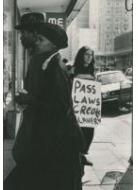When the National Party came into power in 1948 and introduced the policy of apartheid, discrimination and oppression against black people intensified. Women began to take up a more active political role against the government.
In the 1940s and 1950s, a number of women's organisations came into being, all of which linked up with the broader anti-apartheid struggles that were taking place.
A women's charter was adopted at the launch of the Federation of South African Women (FSAW or FEDSAW) in 1954. This charter was drawn up to unite women against political, social, legal and economic injustices Women's Charter.
FEDSAW united the ANC Women's League, the women's wing of the Coloured People's Congress of South Africa, the South African Indian Congress and the Congress of Democrats.
Dora Tamana was elected as President and Ray Simons, a trade unionist and member of the Comunist Party, was elected as the first Secretary of FEDSAW.
FEDSAW supported the Bantu Education boycotts and campaigned against rent increases, housing problems and passes for women. FEDSAW was never banned, but it was hard hit by the banning of its major affiliate, the ANC Women's League on 7 April 1960.
Another significant women's organisation was founded in 1955. Black Sash was an organisation of white women who protested agaist changes in the constitution that removed the right of coloured people to vote. They later became active in providing support to people who ere arrested for violations of pass laws and to communities faced with forced removals.
Exhibitions in the classroom
Reading the Past:
SOURCE: The Women’s Charter. FEDTRAW pamphlet, date unknown.
The Women’s Charter was adopted at the launch of the Federation of South African Women in 1954. This original document outlines the aims of this charter. Read the charter and then answer the questions.
1. Draw a table with two coloumns to identify which aims of this charter is related to women’s struggles and which related to the role of women in the struggle.
2. Do you think it is important that women have their own charter separate from men? Explain your answer.
Reading the Past
In 1983 P.W. Botha introduced a new constitution. This called for a Tricameral Parliament in which there would be three houses – one for white people, one for Indian people and one for Coloured people. Black people were excluded from any political involvement. Instead, the Koornhof Bills allowed for Black people to vote for town councillors who were meant to look after their interests. Elections for this new parliament were meant to take place in September 1984. It was in this context that the commemoration of Women’s Day took place in August 1984.
Read through this source and answer the questions.
1. What are the main issues that this invitation is calling on women to challenge?
2. How does this invitation reflect the political role that women played in the struggle?








